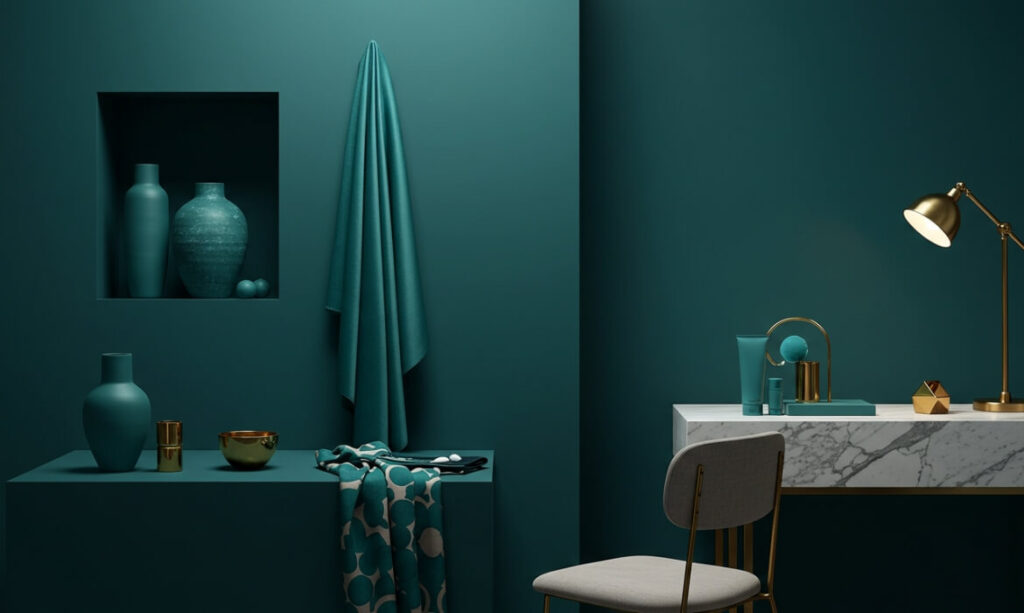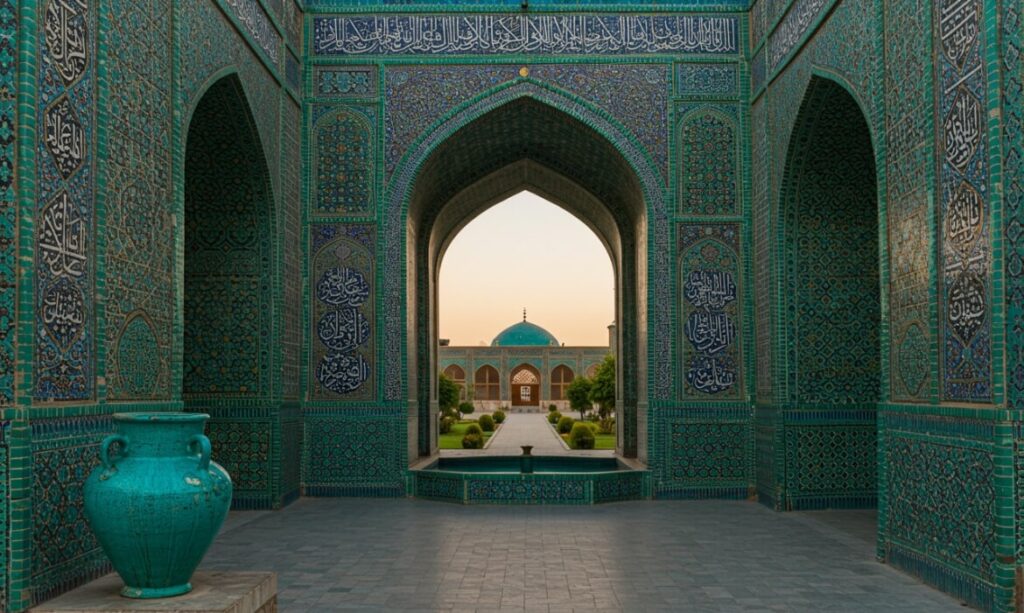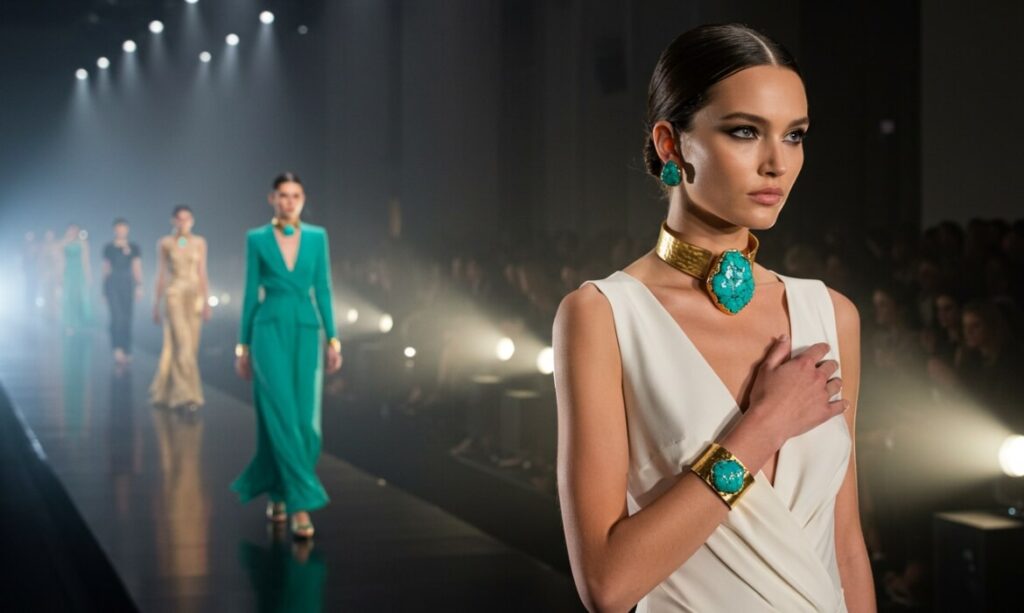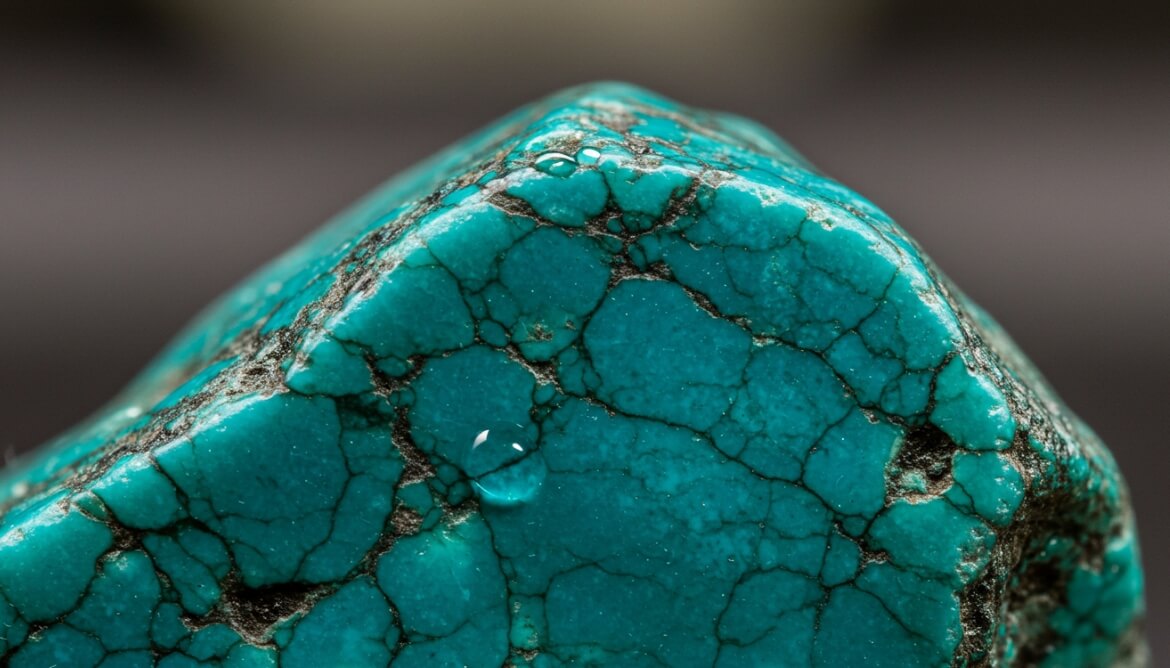Dark turquoise has been used in seven different ways in history, design, and fashion.
When most people hear the word “turquoise,” they think of a bright, fun blue-green color that looks like tropical waters or bohemian jewelry. But dark turquoise is a whole different story. It has a depth, mystery, and elegance that lighter turquoise just can’t match.
Over the years, dark turquoise has made its way into sacred buildings, high-fashion runways, branding strategies, and digital design palettes. It’s both old-fashioned and new, and it can change with the times.
This article will show you seven different ways that dark turquoise has been used in art, culture, science, and design. These examples will show you how it still affects both our emotions and the way we see things.
Table of Contents
1. The Psychology of Dark Turquoise in Branding

Calm Authority in a Color
In branding psychology, blue is linked to trust and green is linked to balance. Turquoise, which is in between the two, makes people want to talk and come up with new ideas. This color gets heavier when it gets darker, though.
How to Stand Out in Competitive Markets
Color fatigue is a problem in a lot of areas. For example, tech companies get a lot of bright blues, while eco-friendly companies get a lot of soft greens. Dark turquoise is in a nice place that people don’t use very often. It’s unique enough to stand out, but it’s also flexible enough to fit in with a lot of different situations.
This color is often used by boutique hotels to make themselves stand out because it is both classy and welcoming. In high-end wellness centers, it means both relaxation and exclusivity, which is exactly what clients are willing to pay for.
2. Past uses in Art and Architecture

Ancient Sacred Spaces
People in ancient Egypt liked to use turquoise to make jewelry, amulets, and other ceremonial items. The most common color was a lighter turquoise, but archaeological evidence shows that darker shades were used from time to time, probably for religious or royal reasons. Because they were so rich, these darker pigments stood out in temples with low light.
People in Persia and Central Asia liked dark turquoise tiles for their buildings.For example, the Shah Mosque in Isfahan has domes with darker turquoise tiles that go around lighter ones. This makes a big difference when the sun shines on them. The effect was both visual and symbolic, showing how the vastness of heaven turns into the mysteries of God.
Renaissance Status Pigments
People liked bright colors again during the Renaissance, but it was hard to make dark turquoise pigments. Artisans would often crush turquoise stones that weren’t worth much or mix green earth with azurite to get the depth they wanted.
Only rich people could afford these colors because they were so expensive. People used this weird color a lot in royal portraits, cathedral murals, and palace ceilings to show off their wealth and style.
3. The Return of Dark Turquoise and Fashion Trends

From Bohemian to High Fashion
Fashion changes all the time, and dark turquoise has come back several times, from Bohemian to the Runway Luxe. In the 1960s, it was used in bohemian prints with earthy oranges and yellows, which was a nod to the free-spirited style of the time. With satin evening gowns and big costume jewelry like turquoise bracelets, the 1980s made it look new and shiny. It looked great with gold metal.
Minimalism brought color back in the early 2010s, but not in as flashy ways. Structured handbags, silk scarves, and tailored coats in dark turquoise added a pop of color without making them look less classy.
Seasonal Shifts
The colors of the seasons affect when we see this shade more. Spring and summer collections tend to have lighter turquoise tones, while fall and winter collections tend to have darker ones. Dark turquoise goes well with fall fabrics like velvet and cashmere, as well as winter staples like wool coats and leather boots.
Celebrity Influence
After a celebrity shows up, fashion houses often see a spike in demand. When an actress shows up to a movie premiere in a dark turquoise gown, social media buzz can make designers rush to meet the new demand.
4. The Science Behind Dark Turquoise Minerals
Formation and Composition
Turquoise is a mineral that is both a copper and aluminum phosphate and can dissolve in water. The copper gives the blue tones, and the iron gives the green tones by making the color darker. Dark turquoise usually forms in places with a lot of iron or where the conditions make it more saturated.
Some of the most famous places that make this richer color are the Nishapur mines in Iran, some Tibetan deposits, and some mines in Nevada. People often think that stones from these places are of high quality because they are rare.
Durability and Environmental Resistance
Dark turquoise is beautiful, but it is also valued for how well it can handle changes in the environment. In mineral form, a darker shade usually means a slightly denser composition, which can make it less likely to fade on the surface over time. This strength is one reason why historical artifacts with dark turquoise, like jewelry or architectural tiles, still have such bright colors hundreds of years after they were made.
5. Cultural Interpretations Around the World
Middle Eastern Symbolism
In the past, turquoise was thought to bring protection and good luck in Middle Eastern cultures. People think the darker one is even stronger because it is less common. Dark turquoise tiles are used inside mosques in Iran to make a visual barrier that protects people who are praying.
Western Vintage Glamour
The Western culture associates dark turquoise with old fashioned luxury. It reminds me of vintage kitchen appliances, retro houses made during the middle of the 20th century, and Art Deco pieces of jewelry. It is commonly used by designers to resurrect the sense of memory without revoking too far into the past.
Harmony in East Asia
Like people in certain East Asian cultures, darker shades of turquoise represent harmony of forces of nature, particularly water and earth. This connection in ceramics, designs on fabrics and even in the layout of landscape gardens can also be found.
6. Dark Turquoise in Digital Design and UX
An Underused Digital Color
Most brands today choose either very bright colors or very muted neutrals. Dark turquoise is a good middle ground. It’s bright enough to stand out on a webpage, but it’s also deep enough to look professional.
Accessibility and Readability
Bright turquoise on a screen for a long time can make your eyes tired. It is more comfortable for people to use because the darker color makes it less shiny. It’s very useful in places where things need to be clear, like dashboards, medical software, and educational platforms.
Consistency in branding across platforms
If you stare at bright turquoise on a screen for a long time, it can make your eyes tired. The darker color makes it less shiny, which makes it easier for people to use. It’s very useful in places where things need to be clear, like dashboards, medical software, and platforms for learning.
7. Dark Turquoise in Storytelling, Movies and Visual Media
Cinematic Symbolism
Filmmakers often use dark turquoise in costumes and sets to show mystery, emotion, or change. In period dramas, the color can show class or controlled power. You can use it in science fiction to make a scene feel cool and futuristic without going too far into sterile blues.
Photography and Mood Setting
Photographers like to use dark turquoise as a background when they want skin tones to stand out warmly against a cool, deep background. It works best for editorial shoots where the mood is just as important as the subject. It adds depth without making the subject less interesting.
Graphic Novels and Animation
When photographers want skin tones to stand out warmly against a cool, deep background, they like to use dark turquoise as a backdrop. It works especially well for editorial shoots where mood is just as important as the subject. It adds depth without taking away from the subject.
Conclusion:
Dark turquoise can go from holy to fashionable and from old to new, so it’s not just a fad.
This color can be royal or casual, calming or energizing, depending on how you use it. Dark turquoise is still one of the most interesting and useful colors in the spectrum. You can see it on the domes of old mosques, on the clothes of a red-carpet celebrity, or on the screen of a mobile app.
This color shows how some colors can stay in style for a long time if they have the right amount of depth, history, and emotional resonance. This color is a good example of something that doesn’t last long.
FAQs
1. What does dark turquoise symbolize in design?
Dark turquoise often represents balance, sophistication, and depth, making it popular in branding, fashion, and interior design.
2. How is dark turquoise different from regular turquoise?
Regular turquoise is lighter and brighter, while dark turquoise has deeper tones, often with green or muted blue undertones, giving it a richer look.
3. Where has dark turquoise been used historically?
It has appeared in Persian mosque tiles, Renaissance artwork, and vintage fashion, valued for its elegance and rarity.
4. Why is dark turquoise popular in modern interiors?
Its depth makes spaces feel calm yet refined, and it pairs well with both warm metallics and bold accent colors.
5. Can dark turquoise occur naturally in gemstones?
Yes. Variations in mineral composition, especially higher iron content, can create naturally darker shades in turquoise stones.









